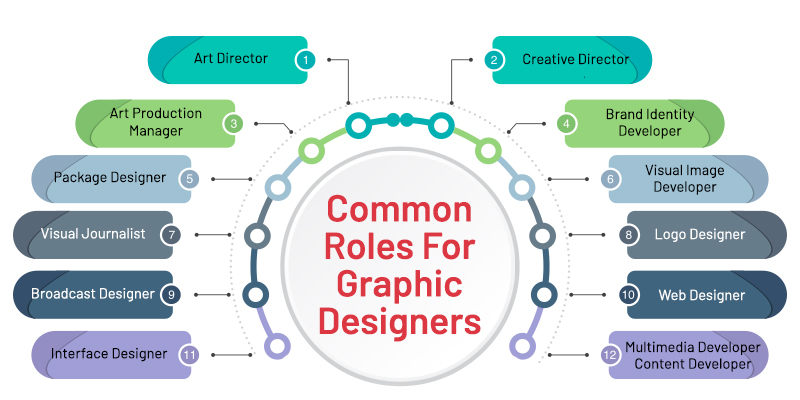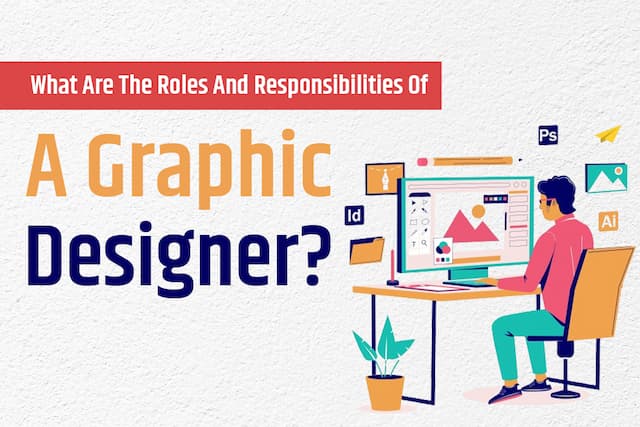
In the modern visually-driven work landscape, the roles and responsibilities of a graphic designer have moved beyond mere aesthetics. Owing to its range of multifaceted roles, this field is offering lucrative pay packages to employees. With an average salary of Rs 4 lakh per annum, the number of graphic designer jobs in 2024 is only expected to rise. Graphic designer roles and responsibilities not just encompass designing skills but also project collaboration, management, a keen understanding of branding, identifying the target audience for advertisement, and so on.
Through this blog, we delve into the multifaceted world of roles and responsibilities of a graphic designer and other key insights that define this dynamic profession.
What Is A Graphic Designer?
A graphic designer is a skilled visual communicator who masters the art of fashioning visual ideas, imagery, and texts through various mediums. They design captivating creatives for digital, print, and multimedia platforms, ranging from ads, logos, websites, labels, and other branding materials. Beyond mere aesthetics, graphic designer roles and responsibilities include analysing client needs, solving design challenges with innovation and ingenuity, and interpreting briefs.
To ace graphic designer jobs in 2024, aspirants must have a solid foundation in design theory and principles, proficiency in industry-standard software, and a promising portfolio.
Ultimately, the roles and responsibilities of a graphic designer are to play a pivotal role in forming and presenting the visual identity of an organisation, business, or brand by creating a lasting impression through their creative endeavours.
Key Roles And Responsibilities Of A Graphic Designer
The basic responsibility of a graphic designer is to make and maintain the company’s visual outlook on both online and offline platforms. However, graphic designer jobs in 2024 demand a range of roles and responsibilities depending on the workplace and specialty. Some key roles and responsibilities of a graphic designer are mentioned below:
- Study and determine the requirements of the design briefs.
- Create designs in tandem with brand design guidelines.
- Create visual concepts, texts, and imagery using modern computer software or simply by hand.
- Share or communicate ideas that motivate and inspire consumers.
- Advise the stakeholders or clients on strategies to engage and influence the target audiences.
- Develop the entire layout and design for products, magazines, brochures, advertisements, banners, and more.
- Design best graphics to cater to any specific promotional or commercial needs like displays, packaging, logos, imagery for printable and digital products.
- Decide how the text and images will be set up to fit in a specific size or layout.
- Collaborate with art directors, clients, and creative team such as sales, marketing, and business operations, throughout the project to gauge scope and deliverables.
- Create infographics to make complex subjects more accessible and easier to understand.
- Test graphics and design across various media.
- Amend designs as per client feedback or stakeholder interest.
- Review the final graphic designs for errors or typos before publishing.
- Meet project deadlines.
- Gain knowledge through certifications or upskill to stay abreast with the latest tools and technologies.
Common Roles For Graphic Designers

After analysing the responsibilities of a graphic designerr, it’s time to unfold the variety of jobs that come under the huge segment of graphic design. Some of the most common roles are:
- Art Director
- Creative Director
- Art Production Manager
- Brand Identity Developer
- Package Designer
- Visual Image Developer
- Visual Journalist
- Logo Designer
- Broadcast Designer
- Web Designer
- Interface Designer
- Multimedia Developer Content Developer
Qualifications Required For Graphic Designer Jobs In 2024
There are several paths job-seekers can take to become a qualified graphic designer. However, most graphic designers have a bachelor’s degree in graphic design or a diploma in the same or related field. Furthermore, to earn a graphic designer job in 2024, aspirants will need to develop knowledge, skills, and software experiences to enhance their work portfolio. The below-mentioned skills will boost the hiring chances of candidates:
Hard skills for graphic designers:
- Typography
- Colour theory
- Understanding of core design principles
- Motion graphics
- Logo and visual identity
- Adobe Photoshop, Acrobat, Illustrator
- CorelDRAW
- InDesign
- Spatial dynamics (layout)
- CAD software (for 3D design)
- CSS (for web only)
Note: The list above identifies the skills employers seek in creative graphic designers. A fresher is not expected to master all these skills but a handful of them will surely be of much help!
Soft skills for graphic designers:
- Creativity
- Written, verbal, and visual communication skills
- Attention to detail
- Problem-solving
- A positive approach to feedback and adapting a design
- Persistence
- Organisation
- Teamwork
- Time management
Different Types Of Graphic Designers
Based on the graphic designers roles and responsibilities, they can be broadly classified under three segments. They can work in-house for one brand or company; at an agency, they work with an array of assigned clients, and as freelancers, they run their creative and design business.
1. In-House Graphic Designers
Established brands and companies employ in-house graphic designers who possess a host of general design skills that can cater to the various needs of a company. The roles and responsibilities of a graphic designer in-house vary from one brand to another and include work like designing new marketing campaigns, creating long-term design ideas and strategies, and even compiling annual reports.
This is more of a traditional work environment with a regular work schedule and steady pay cheques. Depending upon the size of the firm, an in-house graphic designer will either work alone or with a team of designers. And since these designers work to build the brand name, they require in-depth knowledge and understanding of the brand or organisation they are working for.
2. Agency Graphic Designers
Agencies typically work for a plethora of clients whose needs largely vary. Therefore, agency graphic designers work on specific campaigns and short-term projects. These designers work in a fast-paced environment and possess expertise and specialisation in several design areas.
Agencies provide the best opportunities for entry-level designers to learn from seasoned and established designers and sharpen their skills to master stellar designs and creatives.
3. Freelance Graphic Designers
Self-employed graphic designers run the entire show themselves. From designing processes to issuing invoices, and managing clients, successful freelance graphic designers are business-savvy and self-motivated.
Along with greater flexibility, they are in control of their schedule and selective about the projects they wish to work on. However, no matter how solid their client base is, they will always need to seek new leads and opportunities from new clients. There is a large disparity in payment and the amount of work offered.
Type Of Industries Or Companies That Hire Graphic Designers
As graphic design is integral to marketing and branding, Graphic Designers can enjoy working for a wider range of companies. The top industries that employ the maximum number of Graphic Designers are:
- Television and Video Production: With motion graphic design gaining more momentum, television and video production firms are hiring individuals who excel in handling graphic designer roles and responsibilities by creating ads, title sequences, and video clips.
- Internet and software development: Technology develops every passing minute and therefore the demand for graphic designers is rapidly on the surge!
- Corporate Branding: Modern businesses focus largely on their brand image online and graphic designers can be helpful in this arena.
- Manufacturing: Units engaged in manufacturing are on the constant lookout for individuals who can excellently develop their product packages that will influence and encourage potential customers.
- Advertising: Ad agencies hire graphic designers with multiple areas of expertise. Among other roles and responsibilities of a graphic designer, ad agencies require skilled professionals to communicate with clients to meet their requirements and timelines.
Reasons To Become A Graphic Designer
If you have a creative streak and you relate to the roles and responsibilities of a graphic designer, we bring you several other reasons to convince you to become a graphic designer:
- Design is Here to Stay: Whether it is packaged products or websites for advertisements, creative designs will never fade. Human creativity is always in demand to tell stories with imagery and captivate consumers. The age of automation will not harm graphic designer jobs in 2024 and the future!
- Learning and Growing will not Stop: Graphic design is the field for learners who are ready to get inspired for a lifetime! This career promotes constant skill-building. Employees get to learn from endless great examples and new ideas that can help them with their jobs literally everywhere.
- Continue Your Creativity: Artistic or creative people do not have many options to showcase or exercise their creativity in a traditional workplace. But thanks to the graphic designer roles and responsibilities, people with an affinity for design allow you to do what you love daily in a unique work environment.
- Pathway to Several Careers: A graphic design career firstly allows you to work virtually for any company or industry in the city of your choice. Whether your interest is in hospitality, sports, or publishing, the scope is unlimited! Plus, there is a transition benefit. With a strong portfolio and resume, you can position yourself in the field of web design, UX design, product management, and so on. Design skills are demanded and valued everywhere.
- Your Work Might Capture the Spotlight: It is inspiring for graphic designers to see their work published in magazines or billboards! Even the work of other creators motivates them to excel in their designs and get displayed prominently. Graphic designers know that their stellar design pieces can help them capture the spotlight!
| Latest Category Jobs | ||
|---|---|---|
| Job Information | Apply Job | |
Animator For Automotive and Engineering animations(0-2 years) | ||
Memory Design Engineer(2-13 years) | ||
Graphic Designer Internship(0-1 years) | ||
UI/UX cum Product Designer (work from home)(0-3 years) | ||
Conclusion
In conclusion, the roles and responsibilities of a graphic designer cover far more than meets the eye. Moving beyond creating visually appealing designs, these professionals cater to brand stewardship, understanding user experience (UX) principles, problem-solving and collaboration, and so much more! As graphic designers rule and navigate the design domain, they act as catalysts for innovation, effective communication, and creativity, redefining the visual world we inhabit.
Furthermore, gauging the growth of this dynamic career and graphic designer jobs in 2024, enrolling in a course for UX design or web design seems to be the best move to advance your career.
Finally, try Rozgar.com to build an appealing graphic designer resume and find the best graphic designer jobs in 2024.
Frequently Asked Questions
Some of the most in-demand graphic design jobs of 2024 are Motion Designer, Product Designer, UX Graphic Designer, and Illustrator.
In the US, the average Graphic Designer earns between $55,000 to $80,250. Entry-level employees earn approximately $40,000 to $49,000 per year. The average salary of top-tier employees like Art Directors and Creative Directors averages $76,600 and $110,000 per annum simultaneously.
It must be noted that upskilling and specialisation can increase the average largely. For instance, UI Specialists can earn $8,000, Web Designers around $60,000, and UX Designers can easily make $89,000 per year!
Collaboration largely depends on the work environment of any organisation or brand. However, the role is cross-functional, and graphic designers are expected to work with design teams, photographers, videographers, content writers, marketing managers, and other creative people. They might get to work in tandem with public relations, information technology, sales, user experience (UX) design, and so on.
If you are a creative person with a deep knowledge of colour, design, and great imaginative qualities, you can excel as a graphic designer. An ideal graphic designer is a professional whose content resonates with the audience and someone who can easily work with modern designing and marketing tools. This helps them in designing quality content that doesn’t only satisfy the customer or client’s need but also matches the ever-evolving technical world.
Graphic designers must be able to use software tools to bring their ideas to life. Some of the best modern tools are Photoshop, Illustrator, Sketch, InDesign, and After Effects.



